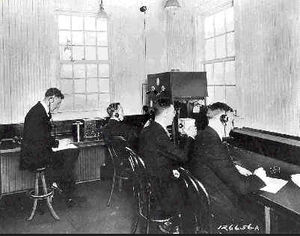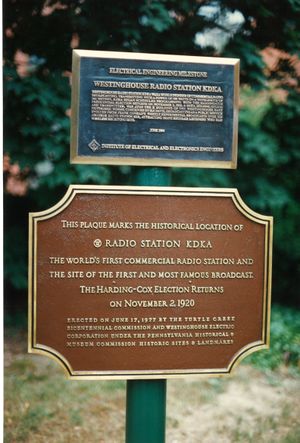Milestones:Westinghouse Radio Station KDKA, 1920
- Date Dedicated
- 1994-06-01
- Dedication #
- 25
- Location
- Pittsburgh, PA, U.S.A.
- IEEE Regions
- 2
- IEEE sections
- Pittsburgh
- Achievement date range
- 1920
Westinghouse Radio Station KDKA, 1920
Westinghouse Radio Station KDKA
Westinghouse Radio Station KDKA was a world pioneer of commercial radio broadcasting. Transmitting with a power of 100 watts on a wavelength of 360 meters, KDKA began scheduled programming with the Harding-Cox Presidential election returns on November 2, 1920. A shed, housing studio and transmitter, was atop the K Building of the Westinghouse East Pittsburgh works. Conceived by C.P. Davis, broadcasting as a public service evolved from Frank Conrad's weekly experimental broadcasts over his amateur radio station 8XK, attracting many regular listeners who had wireless receiving sets.
The plaque may be viewed at Keystone Commons, 700 Braddock Ave, Pittsburgh, PA Dedicated June 1994 - IEEE Pittsburgh Section
"Will anyone hearing this broadcast please communicate with us, as we are anxious to know how far the broadcast is reaching and how it is being received."
A small but entranced KDKA audience heard this message interspersed between election returns and occasional music throughout that station's first broadcast from 6 p.m., election night, November 2, 1920, to noon the following day. From a wooden shack atop the Westinghouse Company's East Pittsburgh plant, five men informed and entertained an unseen audience for eighteen hours. On hand as "chief engineer" of the station was Donald G. Little. R. S. McClelland and John Frazier handled telephone lines from the old Pittsburgh Post newsroom where the returns were received. William Thomas served as station operator and Mr. Leo H. Rosenburg acted as announcer throughout that stormy night. Although it was this election night broadcast which first riveted national attention to KDKA, the station finds its antecedent several years earlier in 1916 as amateur experimental station 8XK, licensed to Westinghouse engineer Dr. Frank Conrad. The station was not an ordinary amateur station-the 'X' indicated a special experimental license-any more than Conrad was an ordinary amateur. He was assistant chief engineer of the Westinghouse Company. This outgrowth of a friendly challenge which centered on timepieces and their accuracy and thus required the ability to receive the Naval Observatory radio station, soon became a major activity of Dr. Conrad's professional engineering career . This station's first official listing appears in the July 1, 1916 edition of the Department of Commerce's Radio Stations of the United States.
While most of the nation's amateurs were forced to cease operations for the duration of World War I, Westinghouse was issued special licenses 2WM and 2WE and continued experimental radiotelephone work for the military throughout the War. "Two stations were designed, equipped, and operated during the war. One was located near its plant at East Pittsburgh, Pennsylvania, and the other at the home of Dr. Frank Conrad in the Pittsburgh residential district, a distance of four or five miles separating the two stations," Almost as soon as he was permitted to do so after the war, Conrad went back on the air. 8XK was relicensed as a "special land station'. presumably between June 15 and August 1, 1919. Amateur stations, as a class, were not allowed to resume operations until 1 October 1919. On 17 October 1919, Conrad delighted "hams" all over the country by substituting a phonograph record for their usual conversation about wireless equipment. In response to the flood of requests for particular musical selections, Conrad was forced to announce that instead of complying with individual requests, he would broadcast records for two hours each Wednesday and Saturday evenings. This twice-a-week program schedule was continued with live vocal and instrumental talent provided from time to time by Dr. Conrad's two young sons, Crawford and Francis, who acted as announcers and played the piano. The other program material was largely phonograph records, although there were some talks as well as baseball and football scores. Even such unsophisticated programming as this was a marvel, and the programs were greeted by rave reviews from columnists in the Pittsburgh Gazette Times.
Excerpt from "Broadcasting's Oldest Stations: An Examination of Four Claimants"
by Joseph E. Baudino and John M. Kittross
Journal Of Broadcasting, Winter, 1977, pp. 61-82
Further Reading
- KDKA: The Radio Telephone Broadcasting Station Of The Westinghouse Electric And Manufacturing Company At East Pittsburgh, Pennsylvania, D. G. Little, NA, Proceedings of the IEEE, 1998
- Westinghouse Radio Station at Saxonburg, Pa., R. L. Davis; V. E. Trotjant, Manager, Radio Engineering Department, Westinghouse Electric and Manufacturing Co., Chicopee Falls, Mass; NA, Proceedings of the Institute of Radio Engineers, 1932
- KDKA, D. G. Little; R. L. Davis, Radio Engineering Department, Westinghouse Electric and Manufacturing Company; NA, Proceedings of the Institute of Radio Engineers, 1926
- Power equipment at KDKA's new station, R. L. Davis, Westinghouse Elec. & Mfg. Co., Chicopee Falls, Mass., Electrical Engineering, 1931
- KDKA to use new 200-kw. tubes, Journal of the A.I.E.E., 1930
- Power Equipment at New KDKA Station, R. L. Davis, Westinghouse Electric and Mfg. Co., Chicopee Falls, Mass., Transactions of the American Institute of Electrical Engineers, 1931
- KDKA, The Radio Telephone Broadcasting Station of the Westinghouse Electric and Manufacturing Company at East Pittsburgh, Pennsylvania, D. G. Little, Radio Engineering Department, Westinghouse Electric and Manufacturing Company, East Pittsburgh, Pennsylvania, Proceedings of the Institute of Radio Engineers, 1924
- Short-Wave Radio Broadcasting, F. Conrad, Westinghouse Electric and Manufacturing Company, East Pittsburgh, Pennsylvania, Proceedings of the Institute of Radio Engineers, 1924

